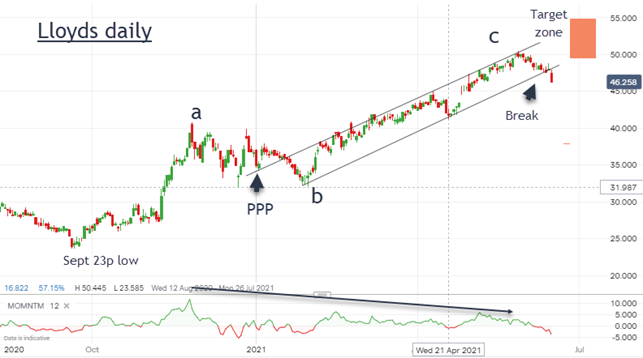Chart of the week: Lloyds Bank shares and the art of profit-taking
21st June 2021 12:20
by John Burford from interactive investor
After taking some profits in Lloyds Bank, chartist John Burford has an update on where the shares might be heading next.

Lloyds Bank shares ease – was I wise to take profits earlier?
As I never tire of saying, shares are not the marrying type. Unless you are very lucky, very few shares are worth holding on to for year after year (and sadly, these cannot be reliably selected in advance). For most of us, we are interested in not just the dividends, if any, but also the capital value of our holdings. And we all know that these can fluctuate wildly.
In an ideal world, most investors (and certainly all traders) need to know when is a good time to head for the exit. We would like to maximise our gains not just on paper but in our account in real money.
- Invest with ii: Top UK Shares | Share Prices Today | Open a Trading Account
Basically, buying a share is easy – selling it near a high is a lot more difficult. But so few try to master the art of profit taking. And that leads to sub-par performance. We spend much more effort in learning how to buy. And that is a mistake. I have spent years studying target profit-take levels on charts, so today I will go over my recent actions in Lloyds Banking Group (LSE:LLOY) as outlined in my COTW articles.
- Lloyds Bank: signs it’s time to sell
- Why reading charts can help you become a better investor
- Check out our award-winning stocks and shares ISA
Sadly, many investors only exit when the shares have lost much value off their high. It is so easy to rationalise declines as 'temporary' and just 'see what happens'. But sometimes, dips are just that and uptrends quickly re-establish. But at other times, the dips turn into major set-backs and we anguish over whether to take what remains of our profits. Indecision rules!
And trading off the news – as so many do - is so hit-and-miss. What we believe is a major news event that would surely hit the market hard, is often met with a small brief reaction before the uptrend is quickly resumed. If we were panicked into selling on that news, we miss out on further gains which could be substantial. Naturally, we feel foolish and miserable at our poor judgment. And that is no place for anyone to make sensible decisions.
I have been a bull on Lloyds since the Corona Crash low of March 2020 and again last September when it made its famous 23p low. Then, bank shares were some of the most hated as visions of waves of bankruptcies were forecast, as were major house re-possessions and mortgage defaults. House prices were set to tumble according to many economists. Hah! With sentiment so bleak, bank shares were surely in the bargain basement – and we bought.
But as confidence slowly returned last year and into this, a much more bullish scenario was being painted as the economic effects of the pandemic were much milder than feared given the huge stimulus efforts. But has the new-found enthusiasm run its course?
In my COTW of 1 June, I laid out my case for taking profits in my target range of 50–55p. Here is the updated daily chart:

Past performance is not a guide to future performance.
From my 'b' wave low I figured we were in the final 'c' wave of what I believed would be a three-wave upward correction off the 23p low. If so, then I expected this large correction to hit major resistance in the 50-55p range, and it became my goal to take profits there if shares entered this range. Of course, that may not be the end of the rally given time, but a decent correction should start there.
Lo and behold, the shares did hit a high of 50.5p on 1 June which is within my target zone. Since I am a pretty conservative trader, a prudent strategy was to take half profits there and retain the other half. That allows for further potential gains. But if the shares have started a major decline, we have a profit in the bank and have the option of exiting the other half at our leisure. That is stress-free trading that I highly recommend.
So was it wise to take profits at the high? The shares have now broken below the lower tramline and that is a potentially bearish signal given the large momentum divergence into the high.
John Burford is the author of the definitive text on his trading method, Tramline Trading. He is also a freelance contributor and not a direct employee of interactive investor.
These articles are provided for information purposes only. Occasionally, an opinion about whether to buy or sell a specific investment may be provided by third parties. The content is not intended to be a personal recommendation to buy or sell any financial instrument or product, or to adopt any investment strategy as it is not provided based on an assessment of your investing knowledge and experience, your financial situation or your investment objectives. The value of your investments, and the income derived from them, may go down as well as up. You may not get back all the money that you invest. The investments referred to in this article may not be suitable for all investors, and if in doubt, an investor should seek advice from a qualified investment adviser.
Full performance can be found on the company or index summary page on the interactive investor website. Simply click on the company's or index name highlighted in the article.
Disclosure
We use a combination of fundamental and technical analysis in forming our view as to the valuation and prospects of an investment. Where relevant we have set out those particular matters we think are important in the above article, but further detail can be found here.
Please note that our article on this investment should not be considered to be a regular publication.
Details of all recommendations issued by ii during the previous 12-month period can be found here.
ii adheres to a strict code of conduct. Contributors may hold shares or have other interests in companies included in these portfolios, which could create a conflict of interests. Contributors intending to write about any financial instruments in which they have an interest are required to disclose such interest to ii and in the article itself. ii will at all times consider whether such interest impairs the objectivity of the recommendation.
In addition, individuals involved in the production of investment articles are subject to a personal account dealing restriction, which prevents them from placing a transaction in the specified instrument(s) for a period before and for five working days after such publication. This is to avoid personal interests conflicting with the interests of the recipients of those investment articles.